
Journal of Fundamentals of Renewable Energy and Applications
Open Access
ISSN: 2090-4541

ISSN: 2090-4541
Short Communication - (2020)Volume 10, Issue 5
The most common type of renewable energy resources is hydroelectric energy plants. In this type of energy plants, knowing flow rate and head level enables to make estimations about power generation and future energy planning. It is very important to make both short-term and long-term estimations in hydroelectric power plants for a good power generation planning. Therefore, in this study Innovative Sen Method has been used for long-term power generation estimations and Artificial Neural Networks have been used for short-term power generation estimations at Dogancay 1 and Dogancay 2 hydroelectric power plants, located in Central Sakarya Basin of Turkey. In Innovative Sen Method, daily total energy generation levels from 2014 to 2018 have been used; and in short-term estimation, Phyton software has been used for Artificial Neural Networks. Short-term estimation was made until year of 2030. As a result of study, high R2 and low MSE values at Artificial Neural Networks model showed accuracy of model for Dogancay 1 and Dogancay 2 hydroelectric power plants located on Sakarya River. As a result of innovative Sen Method, a prospective decreasing trend has been observed in energy generation of Dogancay 1 and Dogancay 2 hydroelectric power plants.
Hydroelectric Energy Plants, Artificial Neural Networks, Innovation Sen Method, Energy, Dogancay
Water it is vital source of life and so it should be one of top priorities to manage and protect water resources. It is necessary to understand and manage water sciences in order to meet requirements of these priorities (Kilicer 2000).
Today, as industrialization increases, need for energy consumption has been increasing. Energy is required at every stage of daily life. Difference between countries’ power generation and energy consumption levels plays an important role in terms of evaluating level of development. Energy must be supplied from renewable energy sources in order to protect water resources that are source of life for all living things. Examples of renewable energy resources include hydroelectric energy, wave energy, geothermal energy, solar energy, hydrogen energy, biomass energy and wind energy (Mishra and Coulibaly 2014; Caliskan 2019)
Hydroelectric energy is the most preferred form of renewable power generation. During generation of energy, no fuel harmful to nature is used and it is environmentally friendly. Energy is produced only from water resources. Although initial investment cost of these energy resources is high, it is seen that unit price of energy obtained is more affordable than that obtained from other sources whenservice life and maintenance costs are considered. In 2015, 16.6% of total electricity produced in world and 70% of electricity generated from renewable energy sources were generated using hydroelectric energy sources. Another important advantage of hydroelectric power plants (HEPPs) is that flow of water to be used for energy production, net head of water, and energy that can be produced by obtaining turbine efficiencies can be estimated. In addition, according to data published by Turkey Electricity Transmission Company, Turkey’s electricity consumption has been increasing by 8% each year. Turkey will develop new energy projects to meet need required by such an increase. It is highly important in these kinds of projects to forecast energy to be generated and prepare plans and projects based on these estimations (TEIAS 2013; TEIAS 2015).
Various methods can be used when preparing energy plans and making estimations about energy generation. Artificial Neural Networks is the most reliable method among these and used in academic studies (Al-Saba and El-Amin 1999; Bozkurt 2009; Dogan et al. 2016). Therefore, prospective short-term power generation at Dogancay 1 Hydroelectric Power Plant and Dogancay 2 Hydroelectric Power Plant, located 8 kilometers away from each other in Geyve district of Sakarya province, will be examined using Artificial Neural Networks method in study. Data to be used as inputs in Artificial Neural Networks are water year, flow, net head of water and energy generated. the output will be the energy that will be estimated. Long-term forecast of energy production will be explored with Innovative Sen Method. With this method, long-term forecasts will be obtained by analyzing existing daily total energy production data between 2014-2018.
Looking at similar studies in literature; usually short or long term forecasts was made. In addition, a single method was generally used in studies in literature. but in this study, both short-term and long-term prediction will made in a single study. In addition, both methods will used in a single study. therefore, it will be an exemplary study for similar studies in literature.
Study Areas
In this study, there are two separate study areas as Dogancay 1 Hydroelectric Power Plant and Dogancay 2 Hydroelectric Power Plant.
Dogancay 1 Hydroelectric Power Plant
Dogancay 1 HEPP It is located between Kizilkaya and Orencik Village, about 8 km north of Geyve district center, south of Sakarya province center, within borders of Sakarya province and was established on Sakarya River. Dogancay 1 HEPP annually generates a mean of 171.63 GWh/year of energy. Dogancay 1 HEPP, which has an installed power generation of 15.942 MW, consists of three units with same features. Maximum power generation capacity of Each unit 5.314 MW. Location of Dogancay 1 Hydroelectric Power Plant on Sakarya River is shown in Figure 1. General features of Dogancay 1 Hydroelectric Power Plant are given in table 1.
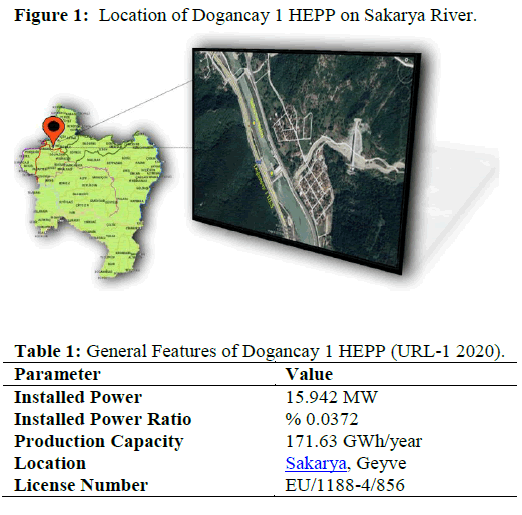
Graph of Daily produced energy in Dogancay 1 Hydroelectric Power Plant is shown in Figure 2. Daily mean net drop graph shown in Figure 3, daily mean efficiency graph shown in Figure 4 and daily mean flow graph is given in Figure 5.
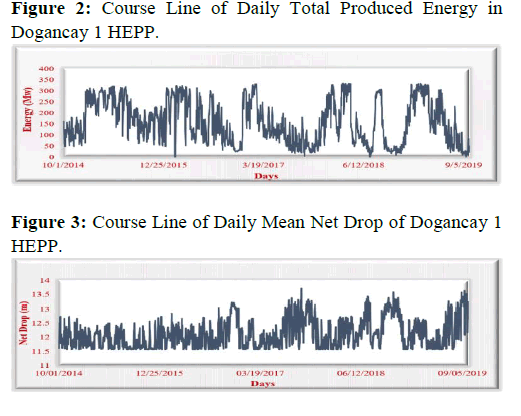
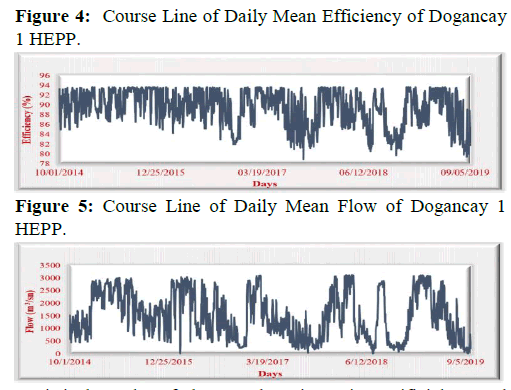
Statistical results of data used as input in Artificial Neural Networks of Dogancay 1 HEPP are given in Table 2.
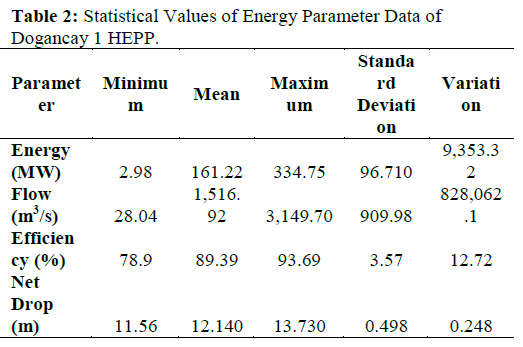
Dogancay 2 Hydroelectric Power Plant
Dogancay 2 Hydroelectric Power Plant It is located within borders of Sakarya province, south of Sakarya province center, approximately 16 km north of Geyve district center, established on Sakarya River. Dogancay 2 Hydroelectric Power Plant annually generates a mean of 171.63 GWh/year of energy. Dogancay 2 Hydroelectric Power Plant, which has an installed power generation of 15.663 MW, consists of three units with same features. Maximum power generation capacity of Each unit 5.221 MW. Location of Dogancay 2 Hydroelectric Power Plant on Sakarya River is shown in Figure 6. General features of Dogancay 1 Hydroelectric Power Plant are given in table 3.
Figure 6: Location of Dogancay 2 HEPP on Sakarya River.
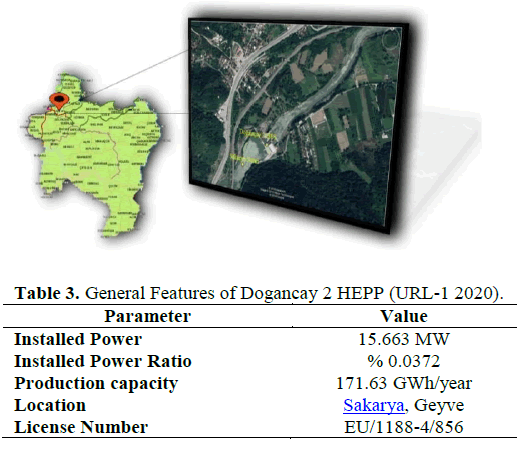
Artificial Neural Networks (ANN) is a system developed in computer system, simulating learning feature in human brain, generating information without any help, making new discoveries and creating information from scratch. It has a structure that functions by imitating human brain and backing up information. It can make a connection between memorization, recall, generalization and data. Biological cells in Artificial Neural Networks has been named neuron, inspired by name of biological cells in human brain. These artificial neurons process signals transmitted and pass them to next neuron, just like those in human brain. Then reactions occur (Oztemel 2016).
Artificial neurons act as processors in ANN. Artificial neurons consist of a number of functions: Input functions, addition functions, transfer functions, and exit functions. The working principle of these cells is as follows: incoming signals are transmitted to nucleus through dendrites (Liang and Cheng 2002; Kiyildi 2017; Yilmaz 2019). The nucleus collects these signals and transmits them to axons. After axons process this data, they are transmitted to synapses and it transfers these new signals to a new cell (Yalcin 2019).
It is important to introduce data to be trained to this network as a dataset. In each output data production, different patterns are read and input data is used. These data are compared to training information. If there is a variability between the compared data, it is changed as the error trend will decrease. These analyzes continue until a decreasing trend occurs. When reliability level in training set reaches desired level, net weights are kept constant and desired output data is produced in model established (Caliskan 2019).
In Innovative Sen Method, existing data is divided into two parts, exactly from middle. These two series are listed from small to large. First data series (Xi) is placed on horizontal axis and second data series (Xj) is placed on vertical axis on cartesian coordinate system (Ceribasi and Caliskan 2019). Arrangement of data in this way is included in figure 11 (Ceribasi and Dogan 2015; Ceribasi 2019). If data is located at top of curve and in low cluster, it is revealed that there is a low increasing trend. if data is located in middle cluster, it is revealed that there is a medium increasing trend, and if it is located in high cluster, it is revealed that there is a high increasing trend. However, it is concluded that there is a low level of decreasing trend if the data is located at bottom of curve and in low cluster. If data is located in middle cluster, it is revealed that there is a medium decreasing trend, and if it is located in high cluster, it is revealed that there is a high decreasing trend (Sen 2012; Sen 2014).
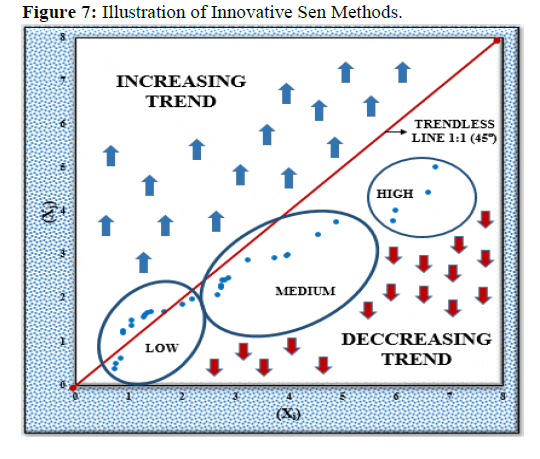
In this study, prospective power generation value estimations have been made by establishing a Artificial Neural Networks model in Pyhton software. The input data selected in this model are as follows: water year, flow rate and Net head. The output values are energy values. There are 3 layers (input, hidden, output) in ANN model created in Phyton software. The number of neurons making up input layer is 32. The hidden layer is divided into 3 layers within itself. First of which consists of 24 neurons, second of 12 neurons, and third of 8 neurons, and output data consists of one layer. The structure of Artificial Neural Network model used in study is given in Figure 8.
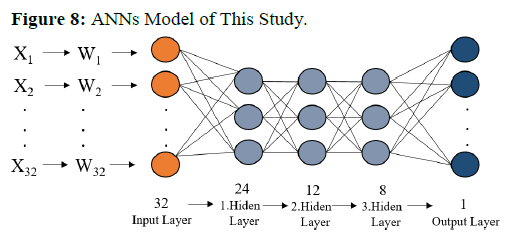
Energy has been major factor throughout history of humanity. The demand for energy increased especially after the Industrial Revolution. While determining sources of energy production, it is important to to protect water resources, mitigate impacts of global warming and to provide energy from renewable energy sources in order not to harm nature. The most common type of renewable energy resources is hydroelectric power plants. In this type of power plants, knowing flow rate and head enables to make estimations about power generation and future energy planning. Therefore in this study, flow charts of energy, flow, efficiency and net head data of Dogancay 1 and Dogancay 2 Hydroelectric Power Plants located in Sakarya Basin were created. In addition, these data were transferred to Artificial Neural Networks model created with Phyton software and a short-term energy production estimate was made. forward-looking long-term energy estimation was made using Innovative Sen Method.
In ANN model of Dogancay 1 and Dogancay 2 Hydroelectric Power Plants data, R2 values respectively has been fond 96.1% and 96.8% and mean squared error values respectively has been fond 0.29% and 0.25%. These results showed that ANN model was very successful and energy data to be generated until 2030 were forecasted. When the result of analysis was analyzed, it has been seen that there was a decreasing trend in prospective short-term energy levels.
Long-term estimation of energy to be generated in both Hydroelectric Power Plants was performed using Innovative Sen Method. In Dogancay 1 Hydroelectric Power Plant, a trend decreasing at a low level occured in energy data between 95-170 MW. There is a decrease at a medium level in nergy data between 180-260 MW while an increase at a high level in energy data between 270-300 MW. In Dogancay 2 Hydroelectric Power Plant, a low trend of decreasing occured in energy data between 25-170 MW. There is a decrease at medium level in energy data between 170-290 MW, whereas no trend is formed in energy data between 300-330 MW.
As the result of the analysis performed with ANN and Innovative Sen Method, it was seen that both methods revealed similar results in two Hydroelectric Power Plants. In addition, as a prospective decreasing energy value is observed in both Hydroelectric Power Plants, it is extremely important that following suggestions should be considered to minimize decrease.
• Sediment retention structures should be built in river bed before upstream to retain solid substances.
• Solid matters filling the stream bed should be cleaned.
• Hydroelectric Power Plants located in the upstream should operate optimally with each other.
In addition to the suggestions mentioned above, the following reccomendations can also be made:
• To minimize the use of fossil fuels consumed unconsciously.
• To generate energy from environmentally friendly and renewable sources.
• Increasing green residential areas that will decrease the levels of greenhouse gases increasing as a result of industrialization brought by the increasing population.
• To raise an awareness among future generations regarding protecting the nature through education.
, DOI: 10.35248/2090-4541.20.10.285
Copyright: This is an open access article distributed under the terms of the Creative Commons Attribution License, which permits unrestricted use, distribution, and reproduction in any medium, provided the original work is properly cited.